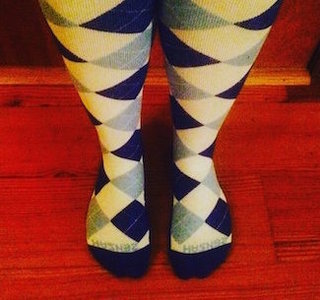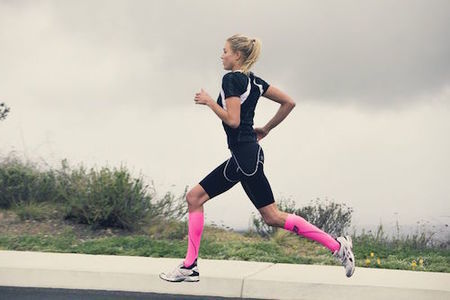It was years after I had the stroke that I learned that I had also had blood clots in my leg (DVTs). After moving to a new city, I mentioned to my new hematologist that one of my calves was bigger than the other. He ordered an ultrasound of my legs and found that the veins in my left leg were damaged. As he put it, “Your veins are like highways and the blood clots turned the ones in your left leg into cobblestone roads.” He also said the valves that normally forced the blood back up the leg had been damaged and no longer worked. When I asked what could be done about that, he said, “Wear compression stockings.”
I was in my early thirties. I pictured the hideous, tan, grandmotherly stockings and balked. I’d take my chances. From having the stroke, I knew I should wear compression stockings on long flights or car trips, but I had never thought of wearing them in the classroom, where I’m on my feet a good portion of the day. As the semesters passed, I realized that the veins in my left leg were beginning to bulge out. I’d like to think it was common sense that brought me back to the idea of compression stockings. To be honest, though, it was probably more vanity. I wondered if I could keep that little bulge in my left calf from becoming a big bulge or worse.
What are Compression Socks/Stockings?
Compression socks/stockings are elastic socks or hosiery that use graduated compression to increase circulation and support the veins of the legs. Their primary purpose is to help prevent blood clots from forming in patients with limited mobility. Lately, however, we see them increasingly used in athletics.
Do They Work?
It depends upon what you mean by work…
Reducing Blood Clots: According to an article in JAMA (the Journal of the American Medical Association), the use of compression stockings after surgery results in a significant reduction in the risk of blood clots.
Treating Varicose Veins: However, a study published in 2013 found “there is insufficient, high quality evidence to determine whether or not compression stockings are effective as the sole and initial treatment of varicose veins.”
Preventing Leg Fatigue: A study in calf-length compression stockings showed that they can reduce or prevent excess fluid in the legs and may therefore be useful for people who have to stand or sit for long periods.
Compression and Athletic Performance
In this area, the research is more speculative and less conclusive. For compression garments for the upper body, there appears to be little or no benefit. An article from the European Journal of Sport Science concluded that wearing UBCG (upper body compression garments) did not provide any significant physiological or performance benefits.
Likewise, a study published in the International Journal of Sports Science & Coaching determined that “the use of a graduated compression sleeve appears not enhance isokinetic elbow flexion muscle performance.”
As for lower body compression, one study showed that waist to ankle compression garments can reduce lactic acid and decrease the heart rate during the post-exercise recovery period. While another study showed no significant difference in cardiorespiratory performance in recreational runners who wore compression stockings.
A more recent review of several studies on compression garments for the lower limbs concluded:
“There was a trend towards a beneficial effect of compression garments worn during recovery, with performance recovery found to be improved in the five studies in which this was investigated, and delayed-onset muscle soreness was reportedly reduced in three of these five studies. There is no apparent relation between the effects of compression garments worn during or after exercise and the pressures applied, since beneficial effects were obtained with both low and high pressures. Wearing compression garments during recovery from exercise seems to be beneficial for performance recovery and delayed-onset muscle soreness, but the factors explaining this efficacy remain to be elucidated.”
So it seems that benefits of compression clothing may be more physiological than physical for improving endurance.
Because athletes are at an increased risk for blood clots, wearing compression socks while running may help lower their risk. Lower Extremity Review points out that:
“Hemostatic activation [blood clot formation] following a marathon is lower in athletes who run with compression socks than those who run with typical athletic socks, suggesting the garments may help reduce the risk of post-exercise clot formation in athletes who travel to events.”
Basically, if you’re a marathoner who travels, it’s a good idea to wear compression socks while training and competing.
Personally, I’m thankful to the athletic clothing industry for introducing much better looking compression gear than what our grandparents had. Though it’s important to note that “the FDA regulates the formula for the compression gradient in compression socks. However, only some companies have chosen to manufacture their products within FDA guide lines. This does not mean that non-standardized socks will not work, but they may be less effective or, in the worst case, create a tourniquet effect.” There isn’t much evidence that compression garments cause a “tourniquet effect” or limit blood flow, but it’s certainly possible. To avoid this, make sure that you follow the sizing guidelines. For instance, with compression socks, you need to measure the calf and not the foot.
What’s the Take Away?
- Compression stockings work for reducing the risk of
 blood clot in patients with limited mobility (after surgery, on long flights, etc.).
blood clot in patients with limited mobility (after surgery, on long flights, etc.). - There is insufficient evidence that they treat varicose veins though they may be helpful in preventing the condition from worsening.
- Evidence shows that wearing compression socks can help lessen leg fatigue in people who
stand or sit for long periods. - There is some evidence that wearing compression socks may speed recovery in athletes though they don’t appear to help actual performance. (especially with garments for the upper body)
- Athletes who travel should wear them when competing to avoid blood clots.
- Compression socks don’t have to be ugly anymore.
Real Risk Study: Birth Control and Blood Clots
Lucine Health Sciences and Hormones Matter are conducting research to investigate the relationship between hormonal birth control and blood clots. If you or a loved one have suffered from a blood clot while using hormonal birth control, please consider participating. We are also looking for participants who have been using hormonal birth control for at least one year and have NOT had a blood clot, as well as women who have NEVER used hormonal birth control. For more information or to participate, click here.












How can I order a pair of those socks I had a stroke the last Monday in March
Thank you, Kerry! I always wear them when I’m traveling. When you need to walk all the time legs start to feel soreness. But now it’s not the problem anymore. Now I can really enjoy the time there, in different places..
I had a DVT at age 30 in 2003 and have worn compression every day since.
The problem with compression as I see it, is that the benefits are so long term that in the short term it looks as if there is no point in wearing any at all.
For the first few years, I still had pain and my leg was still too large to wear my usual trousers. I spent long car journeys with my leg up on the dashboard while my husband drove. By year three and four I could tolerate standing in the shower without compression but not for any longer than that. I cycled, walked, stood, waited tables in restaurants, drove my car and got on with life.
Over the next few years compression just became the thing I wore and no-one ever commented on it. During my 4th pregnancy it kept my leg working despite increased burden on my veins and more swelling again in my thigh.
In the beginning, people asked me if I was becoming dependent on the compression and suggested I should stop wearing it to let my leg do the work but that is to misunderstand what having clot in the femoral vein from ankle to groin does to the valves in that vein. Nothing can be done to make those valves work again and supporting the smaller veins that carry the flow ensures movement of blood and prevents pooling which is what causes ulceration. I ignored them and continued with beige in summer and black in winter on the DVT leg only.
Now at 13 years and counting I had had no ulcers, no varices, no swelling and no more DVTs (mainly due to warfarin though!) Other folks I know who had clots around the same time but didn’t persist with compression have begun to get ulcers and very bad swelling in the last few years as their poor veins begin to grumble about the burden they are struggling with.
My DVT leg is slimmer below the knee than my other leg and I am now focusing on exercising it more as I think I’ve been favouring the ‘good’ leg for too long and that has bulked it up. My DVT leg is still thicker through the thigh but not noticeably so.
I can walk long distances – 6 miles is not a problem, I can stand without pain all day if I need to, and I can sit all day if I need to too. I have a fully functioning and pain-free leg and I really believe that this might not be the case if I hadn’t kept up wearing compression.
So my takeaway is that no study has followed DVT patients for 10+ years which is where I believe the difference between wearing and not wearing begins to show.
Thanks so much for sharing, Rachel. I think you might be right. It sounds like it was really the best thing for you. I also favored my ‘good’ leg for a long time. Then I saw a really great Rolfer (http://www.rolf.org) and she was able to help me get balanced again between both legs. You might find that helpful, too! Best of luck and thanks again for sharing.
Dancing salsa and doing Zumba has made a different to my weight bearing! You can’t favour one leg over the other when you are moving so fast!
That sounds like so much fun! I’ve always wanted to try them!
Great article, and I have come to similar conclusions having reviewed some of the literature. I definitely notice a reduction in muscle soreness after a run using compression socks though!
Thanks Simon. Do you ever wear them when you’re traveling or at other times?